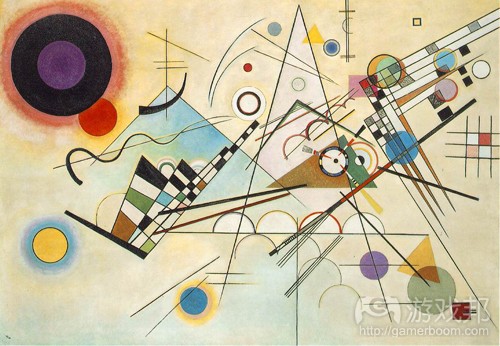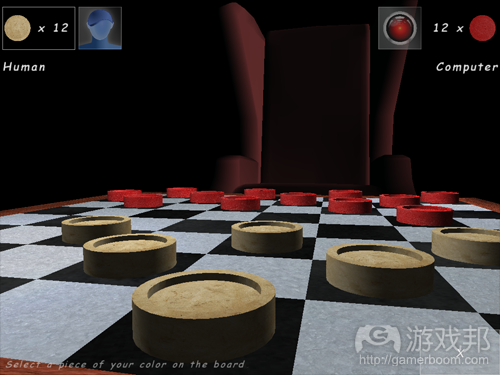探讨电子游戏定义及其艺术性问题
作者:Patrick Holleman
“艺术作品产生规则;规则不产生艺术作品。”——Claude Debussy
艺术是用看的、听的或读的。游戏是用来玩的。这两个说法都正确,但它们的表述都充分吗?你可以玩艺术吗?Roger Ebert曾表示,你不可以玩艺术,至少现在还不行。乍一看似乎不是这么回事,但艺术和游戏之间存在许多概念上的相似点。本文的目的就在于此——证明电子游戏其实可以变成艺术。
这整个论断的最显著问题就是,艺术并没有很明确的定义。正如Ebert所说的,几乎没有什么电影称得上是艺术。如果他认为某部电影是艺术,而其他人不赞同,那么什么才是艺术?难道艺术只是衡量某物好或不好的另一种说法吗?四星级的电影才算得上艺术?我认为我们大部分人都会同意:艺术不只是一种衡量标准。一方面,所有这些电影都不是艺术——那它们是什么?是否存在“好艺术”或“坏艺术”?
游戏设计师Kellee Santiago通过媒体反驳Ebert,从维基百科中引用艺术的定义:“(艺术是指)精心组织元素的过程或产生的成果,能感染人或刺激人的情感。”显然,无论他提出的定义是什么,Ebert都不会同意的。我想我也不会同意,因为艺术的这个定义没有告诉我们实用或精确的信息。为了解决这个问题,我们来看看艺术作品如何对我们产生影响。因为是Roger Ebert惹火了这个话题,所以我们要从他的评论中引用几个例子。
本文将分成三个部分。第一部分将用一个实用的定义回答“什么是艺术?” 第二部分将提问“什么是游戏?”第三部分将从游戏与艺术的相同点入手,显示电子游戏如何变成艺术。
什么是艺术?
在《2000-2009年的十佳电影》一文中,Roger Ebert把《拆弹部队》也列入其中。这是一部关于参加美国和伊拉克战争的爆破小队的电影。出于本文的写作目的,我们可以简单地断定,他可能认为这部电影算是艺术,否则他也不会将它选作这十年中的最佳电影之一了。
对于解释艺术的作用方法,战争电影是一个非常好又直接的例子。一般人并不喜欢战争。确实,甚至许多军人也希望尽可能地在武装冲突上少花时间。为什么?这很容易理解——战争是可怕。那么,为什么非军人的观众(或任何观众)会喜欢看一部将恐惧描绘得淋漓尽致的电影?答案是,观众是在电影院的安全环境下体验战争的危险和刺激。他们并没有真正经历战争,而只是经历了一次艺术体验。
艺术允许观众、听众或读者在不需要切实经历的情况下,用他们的感觉和情绪体验某事物。创造这种体验不是电影的专利。在音乐中,我们甚至能找到更多这样的例子。大多数人都不想体验强烈的悲伤感,然而悲伤的乐曲如柴可夫斯基的第6号交响曲或忧郁的歌曲如Leonard Cohen的《Hallelujah》和披头士乐队的《Eleanor Rigby》,却一直很受欢迎。这是因为听者能够在安全的情绪距离下,体会到音乐所有的悲痛和伤感;并且听者如果愿意,总是能关掉音乐或离开音乐会。正是这种安全的环境和距离才使艺术变得迷人。
有些影片算不上艺术,但它们可以说明艺术是什么以及什么不是艺术。例如,航空公司在飞机起飞以前播放的航班安全信息影片就不是艺术作品;而只是一系列说明,向乘客解释紧急着陆时要怎么做。看到飞机坠毁的细节和人们受难的恐慌场面,可能使乘客至少能体会到一些与飞机坠毁相关的感觉,即使这件事实际上没有发生。这种教育影片不是为了传达紧急着陆的体验,却可能影响机票的销售。艺术的要点是向受众传达他们能感觉到的、可信的体验。因此,航班不会在起飞前播放艺术化处理的影片,而只播放纯粹的教育片。
简而言之,我们对艺术的实用定义就是,艺术是一种允许观众、听众或读者在安全的环境或距离下体验实际上没有发生的事件或情绪的东西。这个定义并不全面,但就被Roger Ebert炒火的争论而言,它已经够用了。
什么是游戏(动词)?
在这个争论的大背景下,最容易做的一件事就是给产生游戏(名词)的东西创造一个实用的定义。大多数读者都会同意:游戏是一种你可以玩的东西。不同的游戏当然有不同的特点,但所有游戏都具有“游戏(动词)”的性质。甚至从隐喻的角度说,名词“游戏”也通常与动词“游戏”联系起来。
所以为了与艺术作比较,我们要回答的第一个问题(但不是唯一的问题)就是,“什么是游戏?”在人类的历史上,游戏的概念经历了很大的演变。另外,我没有说我已经为“游戏”的概念想出一个比较全面的定义。但至于游戏的实用定义,我们可以参看一下这个概念的起源,以得到一个基本的定义。
游戏的最基本含义出自,幼年动物和人类儿童以安全的方式学习。比如,小狗或小猫互相打斗。在大多数情况下,这些小动物不会伤到自己,除非是真正的战斗。那是因为它们并不是真正地打起来,而只是在“玩耍”。又比如,孩子们有时候会让自己扮演海盗,或想象自己是电视节目中的某个角色,然后跟其他孩子开战,用棍子和玩具作为剑和枪等武器。再比如,茶话会中的想象力表演,或装扮聚会,这些都是成年人的模仿行为,都是游戏。
当小动物或儿童之间小打小闹时,会发生什么事呢?大多数时候,这种游戏是一种体验模拟性行为的方式,而不承担那种行为的真实后果。例如,互相撕打的小猫不会发生真正的危险;成年猫之间的决斗却面临危险或遭受严重的身体伤害。挥舞棍子的儿童想象自己在战斗,可能不会伤害对方,即使偶然受伤了也不会非常严重。而真实的枪战往往是致命的。甚至茶话会可能产生可怕的后果,如果参与者太过粗鲁的话,但虚构的身份和填充玩具往往不会太出格。游戏最重要的一方面是,玩家以相对安全和有序的方式展开活动。
从本质上说,游戏允许参与者体验某种活动,而不必真正地从事那种活动。游戏是在安全的、可控制的环境下,理解某种活动的一种方式,学习某种技能的一种方式。规则保护游戏参与者,并体现允许游戏体验产生的安全性。
从以上定义看,游戏和艺术显然有许多共同点。无论是艺术还是游戏,都意味着允许参与者体验他们实际上没有在做的事。在艺术和游戏中,无论是精神上的体验还是身体上的体验都是安全的。
我们要解决的问题仍然不是“游戏可以是艺术吗?”而是,“电子游戏可以是艺术吗?”到目前为止,本文只解释了游戏(动词)的基本属性;但电子游戏是另外一回事。那么,现在我们可以开始探讨游戏,特别是电子游戏如何从基础的玩耍行为开始演变,然后回答电子游戏可不可以是艺术。
游戏的问题
根据上文,游戏的定义有一个明显的漏洞。反对者可能会轻易地提出反驳:“国际象棋没有模仿任何东西,扑克牌也是,但你还是可以‘玩’它们。”确实,在当前时期,我们玩的许多游戏并没有模拟任何真实世界的活动。足球以协调、合作、毅力和良好的体格为基础。培养这些技能和锻炼就是我们玩游戏的充分理由,但游戏的目标是最终取得最高分。然而大多数在玩足球的人,除了想到足球并没有想其他东西;他们没有经历任何模拟或想象性体验。
我们这个时代的游戏在某些方面不同于基础的玩耍。我们说的游戏确实是传统的一种玩耍形式,但游戏不同于传统的玩耍是因为前者有既定的规则来定义和区分它们。玩耍不需要特定的一套规则:儿童在玩耍时不需要遵守特定的规则。但是,当一个人闭着眼睛数到五十,而其他人必须分散地躲起来的时候,这就变成了捉迷藏游戏。与此类似,甚至在仅仅一款游戏中,也可能有非常多种规则;比如,扑克牌游戏的无数变体。
当大部分参与者都将规则作为一种安全的衡量标准时,游戏才能开始。例如,许多专业运动的规则,实际上是为了保护运动员免于不必要的伤害而设计的。但现在我们玩的许多游戏的规则显然改变了许多,并且通常是出于不同的目的。
关于游戏规则的演变,解释之一是,新规则是不惜代价产生新的、有趣的游戏体验的最容易的办法。游戏如扑克牌和国际象棋可以用非常廉价的牌或棋子玩,但问问那些玩冰球、橄榄球或棒球的人,他们使用的设备会便宜吗?在批量生产使所有游戏设备更容易普及以前,如果你已经拥有某种游戏的所有部件,要改变这种游戏的规则会容易得多。那就是为什么用西方的五十二张牌就可以让我们玩到那种多种不同的游戏,只要买一副牌,你就可以玩到很多不同的扑克游戏。
电子游戏却使这种趋势落空了。给任何游戏创造全新的、有趣的规则都是困难的;但借助现代技术,我们可以更轻易地增加电子游戏在艺术上的吸引力。我经常听到游戏评论者报怨道,现在的许多大品牌的游戏在规则上毫无创意。游戏如《神秘海域2》或《战争机器》、《生化奇兵》、《侠盗猎车手》的续作都被玩家指责单纯地遵循一套配方。相同的配方不一定就让这些游戏变糟;却恰恰说明了,大游戏工作室已经意识到重制一款带老规则、活跃的、可信的游戏会更加容易,而不是为玩法发明新规则。图象和声音的更新、剧情和音乐的改进、以及声优和指南的调整都会让游戏更加有趣好玩,即使这些都算不上纯“游戏”的升级。
可信的游戏世界的新乐趣就是一种艺术体验。游戏的规则和玩法机制可能没有多大改变,但置身于一个逼真的、奇异的世界的体验,仍然让许多玩家觉得有趣。电子游戏玩家能够在不同的世界中玩,体验到所有与之相关的东西。这是一种游戏体验还是一种艺术体验?二者兼有,游戏设计师在设计这些游戏时,为了让游戏有趣,有意地在游戏艺术两方面努力。
艺术与游戏的未来
电子游戏,特别是AAA游戏,会渐渐变得更具艺术感,因为现在有这种可能了,也因为艺术游戏已经有受众了。技术上的提高和玩家人数的增多,已经为制作艺术性游戏提供契机。另外,这些艺术上卓越的游戏非常受欢迎。所以自然而然的,在艺术和玩法两方面都具有好品质的游戏会有市场的, 所以做这类游戏的人总是有的。
随着电子游戏开发者更容易构建出逼真的、艺术性的游戏世界,这些游戏会越来越贴近传统的艺术。《星球大战》创造了一个庞大的银河文明;《质量效应》让玩家带着想象探索广阔的宇宙。在《上古卷轴》系列中,托尔金的中土大陆具有漫长的历史、丰富的地形和各种人类,将变得更加宏伟壮丽。甚至以现实世界为背景的游戏,如《暴雨》或《Shenmue》为了吸引更多玩家,也开始构建艺术上可信的世界。
玩艺术作品,也就是居住在一个艺术的世界中,确实地与它互动,这是一个相当新的想法。正是因为太新了,所以我们不能有老方法研究它。我说的老方法是指像电影批评的那种方法,Roger Ebert没有资格评论电子游戏的艺术性(他本人确实承认了)。电影批评、文学批评和音乐批评都不足以解释或评论电子游戏。游戏的技术或专业研究已经存在很久了。编程、音频设计和游戏机制已经是各种学院和大学的研究课程。但如果游戏可以变成艺术,那么必须从艺术的角度研究它们。只有这样,我们才能真正地理解电子游戏到底是什么,以及如何提高它们的艺术性。(本文为游戏邦/gamerboom.com编译,拒绝任何不保留版权的转载,如需转载请联系:游戏邦)
Can Videogames be Art?
by Patrick Holleman
“Works of art make rules; rules do not make works of art.”
-Claude Debussy
Art you watch, listen to, or read. Games you play. Both those statements are true, but are they enough? Can you also play a work of art? In a statement that has become somewhat infamous, Roger Ebert contested that you cannot play art, at least not yet. (Since his original article he has relented and removed himself from the debate.) It may not seem so at first, but there are many similarities between art and play, conceptually. It is the purpose of this essay to show how videogames can in fact be art.
The most obvious problem with this entire discourse is that there is no working definition of art. Ebert, for example, says that very few films are art. If some of the films he reviews are art while others are not, what is art? Is art just another way of saying something is good or not? Are only four star films art? I think that most of us can agree that art is more than just a measurement. For one thing, all those films that are not art—what do we call them? Is there no “good art” or “bad art?”
Kellee Santiago, a game designer who debated Ebert through the media, produced this this definition for art, from Wikipedia: “The process or product of deliberately arranging elements in a way that appeals to the senses or emotions.” Obviously, whatever his definition is, Ebert disagrees. I think I disagree too, because this definition of art doesn’t tell us anything useful or precise. By way of hopefully resolving this problem, let’s take a look at how established works of art work. Because Roger Ebert made this debate famous, we’ll use a few examples from his criticism.
This will break down into three sections. The first answers, “What is art?” with a working definiton. The second section asks “What is play?” And the third section shows how videogames can be art because of the similarities between art and play.
What is Art?
On his top-ten list for films 2000-2009, Roger Ebert includes the film The Hurt Locker. For those who haven’t seen it, it’s a movie about a bomb squad participating in the war between the United States and Iraq. Ebert’s review is available on his website; for the purposes of this writing, we can simply say he probably considers the film to be art, or else he would not have selected it as one of the best films of the decade.
A film about war is a very good and straightforward example of how (in this context) art works. An ordinary person does not enjoy war. Indeed, even many military professionals would like to spend as little time in armed conflict as possible, and it is easy to understand why. War is terrifying. So why would a non-military audience (or any audience) enjoy a film detailing something so horrible? The answer is that the audience is experiencing the action, excitement and drama of the war in the safety of a movie theater. They are not having an actual experience, but rather an artistic experience.
Art allows the viewer, listener, or reader to experience something with their senses and emotions without actually experiencing it in reality. This kind of experience is not unique to film.
In music we find more revealing examples. Most people don’t want to experience intense sadness, and yet sad or tragic musical pieces like Tchaikovsky’s Symphony No. 6 or songs like Leonard Cohen’s “Hallelujah,” and the Beatles “Eleanor Rigby” enjoy enduring popularity. This is because the listener is able to experience all the pain and sorrow of the music at a safe emotional distance, and the listener can always turn off the music or leave the concert if they wish. The safety and distance of the artistic experience are what make it enjoyable.
There are some films which are not supposed to be art, and this helps to further illustrate what art is and what art is not. For example, the flight safety message played on some airlines before an airplane takes off is not a work of art; it is merely a set of instructions explaining what to do during an emergency landing. This film is not meant to transmit the experience of an emergency landing. Seeing a detailed depiction of a plane crash, and the terror of the people suffering the event, would cause the passengers to experience at least some of the feelings associated with a plane crash, even though it isn’t happening. This would probably hurt ticket sales. The point of art is to transmit persuasive experiences that audiences can feel.
Accordingly, airlines do not show artistic pre-flight films, but rather purely instructional films.
So, just as a brief recap, we can say that we have a working definition of art as something that allows the viewer, reader, or listener to safely experience events and emotions that they are not actually having. This is not a completely comprehensive definition of art, but in terms of the discourse made famous by Roger Ebert, it is a good working definition that will serve in the debate.
What is Play?
The easiest thing to do in the context of this debate is to create a working definition for what makes a game. Most readers can agree that a game is something that you play. There are other defining characteristics of games (that vary), but there are no games without the concept of play. Even when speaking metaphorically, the use of the noun “game” is usually connected to the verb “play.”
So the first (but not the only) question to answer, in order to make a comparison to art, is really “What is play?” The concept of play has evolved a great deal in human society. Once again, I do not pretend that I have come up with a completely comprehensive definition of the concept of play. But for a working definition of play, we can turn to the origins of the concept to get a basic definition.
The most basic idea of play comes from what young animals and young humans do to learn and try things in a safe way. Consider the way young puppies or kittens spar with each other. In most cases, these young animals do not hurt each other as they would in a real fight. That is because they are not really fighting, but rather they are “playing.” Or consider what young children often do together: they imagine that they are pirates, or characters from one of their favorite TV shows, fighting fantastic battles, using sticks and toys for swords and guns and anything else they need. Or consider the more cerebral play of an imaginary tea party, or dress-up dolls, both imitations of adult behavior. All of this is play.
But what is happening when young animals play with their litter, or young children imagine various scenarios while they play? In most of these cases, this kind of play is a way of experiencing the imitated action without having to risk any of the real-world outcomes of that action. For example, kittens that fight each other are not in any real danger; adult cats who fight are in danger of serious bodily harm. Children who wield sticks in imaginary fights probably won’t injure each other very seriously, if at all. Actual gun battles are frequently fatal. Even tea parties can get horribly awkward if the guests are rude, but imaginary guests and stuffed animals don’t tend to step too far out of line. One of the most important things about play is that it seeks to do something in relatively safe and orderly manner.
Play, in its most essential form, allows the participants to experience an activity without actually engaging in that activity. Play is a way of understanding an activity, and a way of building skills for an activity, in a safe, controlled environment. Rules protect the participants of play and embody the safety and structure that allows a play experience.
It is obvious that play and art have a lot in common, with these definitions. Both art and play are meant to allow participants to experience things that they are not actually doing. In both art and play the experience is a safe one, whether emotionally, or physically, or both.
Still, the question we are trying to resolve is not “Can play be art?” but rather, “Can videogames be art?” So far this essay has only examined play in its rudimentary state; videogames are different. It makes sense, then, to turn to how games, specifically videogames, evolved from rudimentary play, so that we can say whether or not videogames can be art.
The Problem of Games
There is an obvious problem with the definition of play, given above. An objector might easily say, “Chess is not imitating anything, and for that matter, neither is poker, but you ‘play’ both of them.” And it is true that many games which we play in our current era are not imitating any real-world activity. Football builds coordination, teamwork, perseverance, and good fitness habits. Those skills are a great reason to play the game, but the object of the game is to have the most points at the end. Most people, while playing football, don’t think of anything besides football; they are not having any kind of imitative or imaginative experience.
Games in our era are different in certain respects, from basic play. Certainly, games are a form of play, but games differ from basic play in that they have established rules that define and distinguish them. Play does not need a specific set of rules: children can be “playing” while observing no particular rules. But once they have to scatter and hide while one of them counts to fifty with his eyes closed, it’s hide-and-seek. Likewise, there are a large number of rules that be observed for even one game; consider the numerous variations on the game of poker.
The rules for games probably began the way rules for most behaviors did, as a safety measure. Many of the rules in professional sports, for example, are designed to protect the players from unnecessary injury. But the rules of the many games we play today have obviously evolved a great deal, and often serve a different purpose.
One explanation for the evolution of rules in games is that new rules were the easiest way to make play experiences new and exciting at no cost. Games like poker and chess can be played with very inexpensive game pieces. But ask anyone who plays ice hockey, rugby, or baseball; the equipment can get very expensive. Before mass production made all kinds of game equipment more affordable, it would have been much easier to change the rules of a game for which you already had all the pieces. That is why we have so many different games played with the Western fifty-two card deck, for instance; buy one set of cards, and you have access to dozens of different games.
Videogames defy this trend. Creating new, interesting and fun rules for any game is difficult; and with modern technology it is becoming easier to make videogames more artistically appealing instead. One complaint I hear often from games reviewers is that many of the big-name titles released today contain no new innovations in rules. Games like Uncharted 2, or sequels in the Gears of War or Bioshock or Grand Theft Auto franchises are accused of simply following a formula. This does not make them bad games necessarily; all that this means is that the major game studios have realized that it is just as easy to re-create games with old rules that have more vibrant, artistically persuasive worlds than it is to invent new rules for gameplay. Upgrades to graphics and sound, improvements in writing and music, and better voice acting and direction, all of these will make a game more enjoyable, even if they aren’t purely “game” improvements.
This new enjoyment of a game with a more persuasive world is an artistic experience. The rules and gameplay mechanics may not have changed in a significant way, but the experience of being in a persuasive, strange and exciting world is still enjoyable to many players. Videogame players are able play in a different world and to experience all the things associated with that world. Is this a play experience, or an art experience? It is both, and these games are intentionally designed to be both play and art for the sake of being enjoyable.
Art in the Future of Games
Videogames, particularly major AAA market releases, are going to become progressively more artistic because it is now possible, and because there is an audience for artistic games.
Improvements in technology and a widening audience for videogames have recently made it possible to make games artistic. What’s more, these artistically advanced games are popular. So naturally, now that it is possible to sell games based on artistic quality as well as the quality and originality of gameplay, someone will always be trying to do it.
As it becomes easier for videogame developers to create immersive worlds which are artistically persuasive, those games will have more and more in common with traditional art. Star Wars portrayed an enormous galactic civilization; Mass Effect allows you to explore a universe of the same size and imaginative vision. Tolkien’s Middle-Earth, a world with extensive history, geography, and peoples, is the kind of world that is being built, with increasing grandeur, in The Elder Scrolls series. Even games set in a version of our own reality, like Heavy Rain or Shenmue have begun to construct persuasive worlds that are meant to be inhabited as much as played.
Playing a work of art; that is, inhabiting an artistic world and actually interacting with it is a relatively new idea. Because this is such a new idea, we cannot use old methods to study it. By this I mean that as a film critic, Roger Ebert is not qualified to speak on the artfulness of videogames. (Ebert has actually admitted as much.) On their own, film criticism, literary criticism, and music criticism aren’t really enough to explain or critique videogames. The technical or professional study of games has existed for some time now. Programming, sound design, and game mechanics are courses of study at various colleges and universities. But if games can be art, then they need to be studied from an artistic perspective. Only then can we truly understand videogames for whatt they are, and how they can be made artistically richer.(source:thegamedesignforum)










































 闽公网安备35020302001549号
闽公网安备35020302001549号